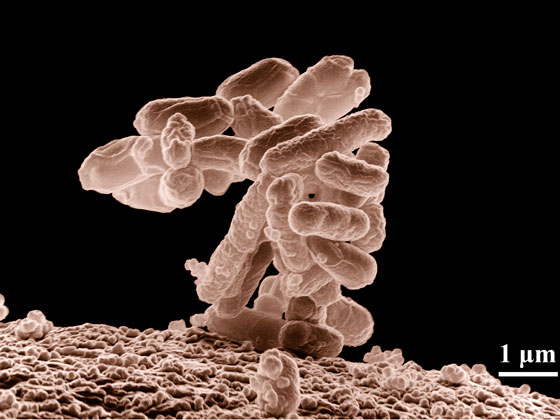New type of travelling wave pattern could contain biological coordinates
16 Dec 2016 by Simon Davies The research may allow new insights into how proteins self-organize, and accurately ‘map’ the surface of a cell, such as E.coli, as it grows. Image: Agricultural Research Service, United States Department of Agriculture.
The research may allow new insights into how proteins self-organize, and accurately ‘map’ the surface of a cell, such as E.coli, as it grows. Image: Agricultural Research Service, United States Department of Agriculture.
‘Stretchable map’ is a logical way to understand how bacteria manage cell division
Physicists in Israel and the US have proposed a new type of travelling wave pattern — one that can adapt to the size of physical system in which it is embedded – reporting the work in the New Journal of Physics.
According to the theory, all of the key characteristics of the oscillation (the number of maxima, minima and nodes) remain the same, over a very wide range of host sizes, which turns out to be an exciting result.
The scientists, David Kessler from Bar Ilan University and Herbert Levine from Rice University, share an interest in the dynamics of non-equilibrium systems – a topic that can often shed light on intricate processes such as those found in nature.
“This work started as an attempt to generate an interesting example of wave patterns for a book we are writing on the overall field of pattern formation,” said Herbert Levine of Rice University’s Center for Theoretical Biological Physics. “Wave patterns are one of the general classes of non-equilibrium structures that can form when systems are driven far from equilibrium.”
Familiar examples include travelling wave patterns that describe the convection of fluid mixtures in response to temperature gradients. However, the researchers were drawn to the oscillatory behaviour displayed by the MIN system – a group of proteins involved in the cell division of bacteria such as E.Coli.
“The MIN system is used to demarcate the centre of a cell so that it divides into two symmetric daughters,” said Levine. “Having a mechanism that allows the wave pattern to ‘stretch’ without changing all that much is a logical way to deal with this cell growth.”
By modelling the behaviour, the researchers found that – unlike other examples of pattern forming processes – the process at work here does not appear to be governed by a precise length scale.
“Because of this, the waves seem to be more adaptable to the size of the region in which they live,” Levine said. “This is an interesting finding from a pure physics perspective, but it may also have some implications from a biological point of view.”
The result could pave the way for new insights into how proteins are able to self-organize and accurately ‘map’ the surface of a cell as it grows. And, in principle, this knowledge may one day help in drug development by alerting scientists to ways of interfering with the spread of harmful bacteria.